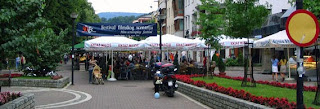Jastrebac is the highest mountain in central Serbia, located between the towns of Kruševac, Niš and Prokuplje. Amongst all Balkan mountains Jastrebac mountain features the dense forests and abundance of waters and springs. It consists of two massifs, Great and Small Jastrebac. It's highest peak Velika Dzulica has an elevation of 1,492 meters above sea level. It is well-forested and presents a popular hiking and mountaineering destination.
Jastrebac is bounded by the rivers of South Morava on the west, Toplica on the south and Rasina on the east. Despite relatively low height, it is prominent because of the surrounding valleys. It is located on the boundary of Dinaric, Balkan and Rhodopes mountain ranges, but cannot be clearly classified into either.
Jastrebac Mountain is specially convenient for nature-lovers, walkers, mountaineers and recreant visitors enjoying easy mountaineering and walking along vast meadows full of springs and waterfalls. The highest summits of Jastrebac mountains are "Ðulica" peak (1491 m) and "Pogled" peak (1481 m) that make the natural border between Toplica river and Pomoravlje area. Thick forests of Jastrebac mountain represent rich raw material for wood-processing industry of Kruševac.
At the southern slopes of Jastrebac mountaint here is the artificial lake with beautiful shore situated in the heart of sunny valley. Variety of trekking walkways are spread along Jastrebac mountain : "Bele Stene" (1257 m), "Stracimira" (1390 m),"Maznice" (1140 m) as well as routes up to the springs and the old St. Petka church or the medieval Gradac fortification.
Jastrebac is bounded by the rivers of South Morava on the west, Toplica on the south and Rasina on the east. Despite relatively low height, it is prominent because of the surrounding valleys. It is located on the boundary of Dinaric, Balkan and Rhodopes mountain ranges, but cannot be clearly classified into either.
Jastrebac Mountain is specially convenient for nature-lovers, walkers, mountaineers and recreant visitors enjoying easy mountaineering and walking along vast meadows full of springs and waterfalls. The highest summits of Jastrebac mountains are "Ðulica" peak (1491 m) and "Pogled" peak (1481 m) that make the natural border between Toplica river and Pomoravlje area. Thick forests of Jastrebac mountain represent rich raw material for wood-processing industry of Kruševac.
At the southern slopes of Jastrebac mountaint here is the artificial lake with beautiful shore situated in the heart of sunny valley. Variety of trekking walkways are spread along Jastrebac mountain : "Bele Stene" (1257 m), "Stracimira" (1390 m),"Maznice" (1140 m) as well as routes up to the springs and the old St. Petka church or the medieval Gradac fortification.















































